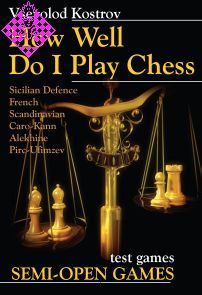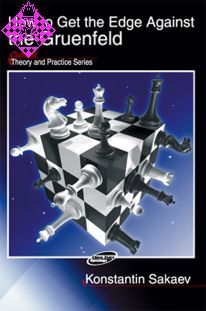Artikelnummer
LOSAKHTGTEATG
Autor
How to Get the Edge Against the Gruenfeld
170 Seiten, kartoniert, Chess Stars, 1. Auflage 2004
Aus der Reihe »Current Theory and Practice Series«
Final vergriffen
This book is highly recommended to all players from club to GM level. The author studies very popular opening system on great depth and recommends a lot of new interesting ideas. In many variations the analysis is supported by author's own practical experience what makes it even more reliable." (A.Khalifman)
Preface
The Gruenfeld Defence (1.d4 Nf6 2.c4 g6 3.Nc3 d5) appeared as an original opening relatively recently. It began to be played at a really high level during the 30ies of the 20th century and quite rarely at that. White used to react even then in the most aggressive and natural way - he was occupying the centre immediately with: 4.cxd5 Nxd5 5.e4. After 5...Nxc3 6.bxc3 Bg7 White had to face the problem how to develop later? The players gradually began to understand that every possible set-up had some drawbacks too. If White played 7.Nf3, then the knight was usually pinned unpleasantly later with Bc8-g4, while 7.Be3 c5 8.Qd2 was slowing the development of the kingside considerably. Nowadays both 7.Nf3, as well as 7.Be3 are popular opening systems with plenty of complexities and fine points too.
I am trying with this book to increase the number of adherents of the line 7.Bc4! followed by 8.Ne2. The dawn of the popularity of the variation was marked by great players like David Bronstein and Efim Geller, but Boris Spassky made the most significant contribution to its development. He won so many brilliant games that he managed to prove that the placement of the white knight on e2 is not as passive as it seemed at first sight. The knight defends the c3 and d4 pawns and can go to f4 at an opportune moment joining in the attack. Sometimes that knight helps the advance of the h-pawn and often it supports the offence with the f-pawn not standing in its way forward.
I used to study the 7.Bc4 system together with Vladimir Kramnik, Sergey Dolmatov and some other famous players. I found numerous new ideas and I made plenty of interesting analyses while working on the book and that helped me win several beautiful games. The reader is going to find one of them in Chapter 5.
I believe that after the games that I played recently Sakaev - McShane, Germany 2003 and Sakaev - Belov, Krasnojarsk 2003, there will be a crisis for Black in the popular lines: 7...c5 8.Ne2 Nc6 9.Be3 cxd4 10.cxd4 Qa5 as well as 7...ñ5 8.Ne2 Nc6 9.Be3 0-0 10.0-0 Bd7 (Chapter 2 and Chapter 5). I have now my reasons to suspect that Black will start to play much more often the main line - 7...c5 8.Ne2 Nc6 9.Be3 0-0 10.0-0 Bg4 11.f3 Na5, and that is one of the basic themes in our book. How should White play here in order to create problems for Black and to obtain an opening advantage? The contemporary theory is not prepared yet to answer that question satisfactorily. I think that the systems 12.Bd3 cd4 13.cd4 Be6 14.Rc1 and also 12.Bxf7+ are the most promising for White. You will find in our book plenty of new and original analyses and recommendations in the corresponding chapters.
I hope that the book will be useful to a lot of readers. The chess-fans will be able to understand the strategy and the fine points of the different systems and to grasp the standard ideas, while the stronger players will come to terms with the modern theory of all critical lines.
This book has summarized the contemporary theory up to February, 1st 2004.
Konstantin Sakaev, February 2004
Preface
The Gruenfeld Defence (1.d4 Nf6 2.c4 g6 3.Nc3 d5) appeared as an original opening relatively recently. It began to be played at a really high level during the 30ies of the 20th century and quite rarely at that. White used to react even then in the most aggressive and natural way - he was occupying the centre immediately with: 4.cxd5 Nxd5 5.e4. After 5...Nxc3 6.bxc3 Bg7 White had to face the problem how to develop later? The players gradually began to understand that every possible set-up had some drawbacks too. If White played 7.Nf3, then the knight was usually pinned unpleasantly later with Bc8-g4, while 7.Be3 c5 8.Qd2 was slowing the development of the kingside considerably. Nowadays both 7.Nf3, as well as 7.Be3 are popular opening systems with plenty of complexities and fine points too.
I am trying with this book to increase the number of adherents of the line 7.Bc4! followed by 8.Ne2. The dawn of the popularity of the variation was marked by great players like David Bronstein and Efim Geller, but Boris Spassky made the most significant contribution to its development. He won so many brilliant games that he managed to prove that the placement of the white knight on e2 is not as passive as it seemed at first sight. The knight defends the c3 and d4 pawns and can go to f4 at an opportune moment joining in the attack. Sometimes that knight helps the advance of the h-pawn and often it supports the offence with the f-pawn not standing in its way forward.
I used to study the 7.Bc4 system together with Vladimir Kramnik, Sergey Dolmatov and some other famous players. I found numerous new ideas and I made plenty of interesting analyses while working on the book and that helped me win several beautiful games. The reader is going to find one of them in Chapter 5.
I believe that after the games that I played recently Sakaev - McShane, Germany 2003 and Sakaev - Belov, Krasnojarsk 2003, there will be a crisis for Black in the popular lines: 7...c5 8.Ne2 Nc6 9.Be3 cxd4 10.cxd4 Qa5 as well as 7...ñ5 8.Ne2 Nc6 9.Be3 0-0 10.0-0 Bd7 (Chapter 2 and Chapter 5). I have now my reasons to suspect that Black will start to play much more often the main line - 7...c5 8.Ne2 Nc6 9.Be3 0-0 10.0-0 Bg4 11.f3 Na5, and that is one of the basic themes in our book. How should White play here in order to create problems for Black and to obtain an opening advantage? The contemporary theory is not prepared yet to answer that question satisfactorily. I think that the systems 12.Bd3 cd4 13.cd4 Be6 14.Rc1 and also 12.Bxf7+ are the most promising for White. You will find in our book plenty of new and original analyses and recommendations in the corresponding chapters.
I hope that the book will be useful to a lot of readers. The chess-fans will be able to understand the strategy and the fine points of the different systems and to grasp the standard ideas, while the stronger players will come to terms with the modern theory of all critical lines.
This book has summarized the contemporary theory up to February, 1st 2004.
Konstantin Sakaev, February 2004
| EAN | 9548782359 |
|---|---|
| Gewicht | 230 g |
| Hersteller | Chess Stars |
| Breite | 14,5 cm |
| Höhe | 21,5 cm |
| Medium | Buch |
| Erscheinungsjahr | 2004 |
| Autor | Konstantin Sakaev |
| Reihe | Current Theory and Practice Series |
| Sprache | Englisch |
| Auflage | 1 |
| ISBN-10 | 9548782359 |
| Seiten | 170 |
| Einband | kartoniert |
1 d4 Nf6 2. c4 g6 3. Nc3 d5 4. cxd5 Nxd5 5. e4 Nxc3
6. bxc3 Bg7 7. Bc4
009 1 7...0-0
010 a) 8. Ne2 b6
013 b) Ne2 Qd7
015 c) Ne2 Nc6
020 d) Ne2 c5
7...c5 8. Ne2 Nc6 9. Be3
023 2 9...cxd4 10. cxd4
023 a) 10...b5
027 b) 10...Qa5
7...c5 8. Ne2 Nc6 9. Be3 0-0 10. 0-0
037 3 10...cxd4
051 4 10...Qc7
061 5 10...Bd7
068 6 10...Bg4
068 a) 11. f3 Bd7
070 b) 11. f3 Na5
070 b1) 12. Bd5
076 b2) 12. Bd3 cxd4 13. cxd4 Be6 14. Qa4
080 7 10...Bg4 11. f3 Na5 12. Bd3 cxd4 13. cxd4 Be6 14. d5
109 8 10...Bg4 11. f3 Na5 12. Bd3 cxd4 13. cxd4 Be6 14. Rc1
137 9 10...Bg4 11. f3 Na5 12. Bxf7
6. bxc3 Bg7 7. Bc4
009 1 7...0-0
010 a) 8. Ne2 b6
013 b) Ne2 Qd7
015 c) Ne2 Nc6
020 d) Ne2 c5
7...c5 8. Ne2 Nc6 9. Be3
023 2 9...cxd4 10. cxd4
023 a) 10...b5
027 b) 10...Qa5
7...c5 8. Ne2 Nc6 9. Be3 0-0 10. 0-0
037 3 10...cxd4
051 4 10...Qc7
061 5 10...Bd7
068 6 10...Bg4
068 a) 11. f3 Bd7
070 b) 11. f3 Na5
070 b1) 12. Bd5
076 b2) 12. Bd3 cxd4 13. cxd4 Be6 14. Qa4
080 7 10...Bg4 11. f3 Na5 12. Bd3 cxd4 13. cxd4 Be6 14. d5
109 8 10...Bg4 11. f3 Na5 12. Bd3 cxd4 13. cxd4 Be6 14. Rc1
137 9 10...Bg4 11. f3 Na5 12. Bxf7
Mehr von Chess Stars
-
 Play the Queen's Indian Defence23,95 €
Play the Queen's Indian Defence23,95 € -
 The Spanish Main Road22,95 €
The Spanish Main Road22,95 € -
 The Easiest Sicilian21,95 €
The Easiest Sicilian21,95 € -
 Semi-Open Games - test games8,95 €
Semi-Open Games - test games8,95 € - Mehr von Chess Stars




